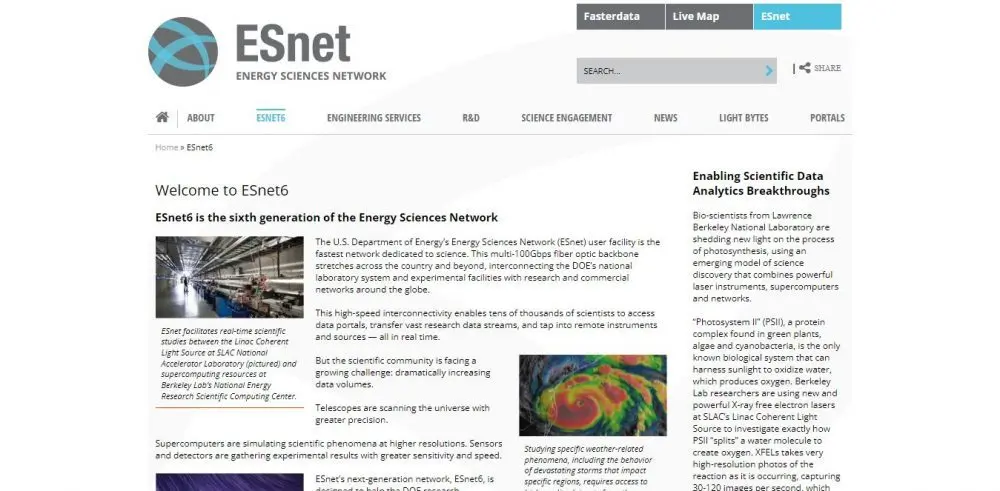NASA stands for National Aeronautics and Space Administration. NASA is a U.S. government agency that is responsible for science and technology related to air and space.
From the first of October 1958, they were open for business and doing research in the field of studying the solar system and beyond.
To do all of this research, it’s most definitely a necessity to have high-speed internet. A lot of data needs to be transported and processed while doing research and we don’t want the slow internet to be a factor in the new technology that is being researched at NASA right?
In this blog, we will be covering what Network NASA uses, How Fast their internet is, how they achieved those results, And why they need such high-speed internet.
How Fast is NASA Internet Speed (NASA download speed)? This was 2013
From an experiment done in 2013, we can learn that the internet speed at NASA easily reaches 91 gigabits per second.
This is a little over 455 times faster than the country with the fastest internet and approximately 5000 times faster than the average internet speed connection.
To give you an idea about how fast this is, imagine downloading a movie in full HD quality in less than a second.
Even though this was an experiment performed on the ESnet, their regular network speeds won’t be that fast.
The experiment was done on a tested network in ideal conditions with the best hardware possible can be.
This means all the equipment was working at its highest capacity. And it would be risky and very expensive, considering the amount of power to run it at full capacity 24/7.
The experiment was just a proof of concept that the ESnet network is capable of very high speeds.
How fast is NASA’s internet speed?
In 2023, the agency has a peak internet speed of 400 gigabits per second (Gbps). This is more than 2,000 times faster than the average internet speed in the United States.
NASA needs its internet to be fast because it needs to be able to transmit and process massive amounts of data. For example, the International Space Station generates about 250 gigabytes of data each day. This data includes images, videos, and scientific data that is transmitted back to Earth for analysis.
NASA also uses its internet to communicate with astronauts in space and to collaborate with scientists and researchers from around the world.
NASA’s high-speed internet is powered by a network of fiber optic cables and satellites. Fiber optic cables are capable of carrying large amounts of data at very high speeds. Satellites are used to provide internet connectivity to remote locations, such as the International Space Station.
NASA’s internet is not just fast, it is also very reliable. The agency has a team of experts who are constantly monitoring and maintaining the network to ensure that it is always up and running.
Here are some examples of how NASA uses its high-speed internet:
- To transmit high-resolution images and videos from the International Space Station and other spacecraft.
- To transfer scientific data from spacecraft and ground-based telescopes to scientists around the world.
- To communicate with astronauts on the International Space Station and other spacecraft.
- To collaborate with scientists and researchers from around the world on projects such as climate change research and space exploration.
NASA’s high-speed internet is essential for its work. It allows the agency to transmit and process massive amounts of data, communicate with astronauts in space, and collaborate with scientists from around the world.
How fast is NASA wifi speed?
The Wi-Fi speeds at NASA can vary depending on the specific location and purpose. In general, NASA facilities would require robust and high-speed internet connections to support their scientific research, data transfer, and communication needs.
In 2013, it was reported that the internet connection at NASA’s Kennedy Space Center in Florida had a download speed of around 91 megabits per second (Mbps) and an upload speed of 49 Mbps. These speeds were based on the available commercial internet service at that time.
Since technology and internet speeds have improved significantly over the years, it is possible that NASA’s Wi-Fi speeds have also increased. However, the exact speeds can vary depending on the facility, available infrastructure, and the specific needs of the individuals and projects within NASA.
For the most accurate and up-to-date information on NASA’s Wi-Fi speeds, it would be best to contact NASA directly or visit their official website for any publicly available information regarding their network capabilities.
What Network Does NASA Use? NASA network speed
Unlike us, NASA doesn’t use any commercial internet providers. They don’t even use the World Wide Web like we do.
This is because the data that they need to send and receive is highly confidential and time-sensitive.
Therefore, they use a network called Energy Science Network for short ESnet.

This is a highly policed network, secured by military-grade security and primarily used for research purposes.
Because they have different field centers across the globe and in different time zones, their network has to be insanely fast because the data that they need to send and receive is time-sensitive.
Read more about ESnet6.
The Importance of Internet Speed for NASA
NASA’s missions involve collecting vast amounts of data from space probes, telescopes, satellites, and other scientific instruments. This data needs to be transferred quickly and efficiently to NASA’s various research centers and scientists worldwide. Timely access to this data enables scientists to analyze and interpret it, leading to valuable insights and discoveries.
Moreover, real-time communication between astronauts in space and mission control on Earth is crucial for ensuring the safety and success of space missions. High-speed internet allows astronauts to exchange critical information, receive instructions, and collaborate with scientists and engineers on the ground.
NASA’s Ground Network
To support its data transfer and communication needs, NASA has established a robust ground network. This network comprises several tracking and data relay stations strategically located around the globe. These stations work in tandem to ensure seamless and uninterrupted communication with NASA’s satellites, spacecraft, and the ISS.
Tracking and Data Relay Satellite System (TDRSS)
NASA’s Tracking and Data Relay Satellite System (TDRSS) plays a vital role in providing high-speed internet connectivity for NASA’s space missions. TDRSS consists of a constellation of geosynchronous satellites that orbit the Earth. These satellites act as data relays, receiving and transmitting information between NASA’s spacecraft, the ISS, and ground stations.
TDRSS enables high-bandwidth communication with spacecraft and astronauts, supporting a wide range of data-intensive activities such as live video streaming, telemetry, command transmission, and scientific data transfer. The system’s high-speed connections ensure that mission-critical information reaches its destination swiftly and reliably.
High-Speed Data Transfer Rates
NASA’s internet speed is exceptionally fast, allowing for efficient data transfer and communication. The agency’s high-speed connections enable scientists and engineers to download large datasets, images, and scientific observations in a matter of seconds or minutes, depending on the file size.
For instance, the downlink speed from the ISS can reach up to 300 megabits per second (Mbps), enabling astronauts to communicate with mission control and access necessary resources promptly. Similarly, data transmission from deep space missions can occur at speeds of several megabits per second, facilitating the transfer of valuable scientific data back to Earth.
Ensuring Reliability and Security
In addition to speed, reliability, and security are paramount in NASA’s internet infrastructure. Redundancy measures are in place to ensure uninterrupted data transmission, even in the event of equipment failure or adverse weather conditions.
NASA’s network is equipped with robust firewalls and encryption protocols to safeguard sensitive data from potential cyber threats. These security measures help protect NASA’s intellectual property, mission-critical information, and communication channels.
Future Challenges and Advancements
As technology continues to evolve, NASA faces new challenges and opportunities in enhancing its internet speed and capabilities. The agency is exploring innovative solutions, such as laser communication systems, to further improve data transfer rates between Earth and space.
Additionally, as NASA plans ambitious missions to Mars and beyond, the need for high-speed and reliable internet connections will become even more critical. Advancements in communication technology will be crucial in enabling seamless communication and data transfer over vast distances.

How Did NASA Achieve This High Internet Speed?
If you travel on a road that has a lot of crossings it would take a lot more time to reach your destination even if you have to go straight forward all the time.
This is because you have to stop more often to see if it is safe to cross the road. If we replaced this road and use a highway instead where there are no crossings and the only way to go is from point A to point B directly, your journey would be so much faster.
This is very similar to the way the network works. The fewer joints, switches, routers, etc. These are called nodes, the faster data can travel through the network.
The ESnet is a network with fewer nodes. Because it is not congested and consists of fewer nodes it reaches insanely fast internet speeds.
The ESnet network can be a lot faster than 91 GB/s. Japanese researchers have achieved 319 TB/s over a distance of 3001 Kilometers.
This is approximately, 3500 times faster than NASA. This shows that the ESnet network can handle a lot of speed.
Why Does NASA Need High-Speed Internet?
You would ask why they need that much speed and security. The straightforward answer is that NASA deals with a lot of data.
Let it be the data from radio telescopes or the high-resolution images from its space telescopes. It even includes the networking they do on the ground, between laboratories and international field centers.
The information they gather daily also needs to be secured because they work on classified or confidential information that will damage national security in the hands of a third party.
Imagine having new deadly technology data related to war machines in the hands of criminals. That could be very catastrophic for humankind, and it’s NASA’s job to protect us from these activities.
That is why they need their data to be very secure.
They also need this data quickly since data from space is extremely time-bound, and delays will cause issues with the experiments they were running or equipment that they were monitoring remotely.
Benefits of High-Speed Internet for NASA
High-speed internet provides several benefits for NASA, including:
a. Faster Data Transfer
High-speed internet enables NASA to transfer large amounts of data quickly and efficiently. This allows the agency to analyze data and make decisions in real-time, which is crucial for mission success.
b. Enhanced Collaboration
NASA’s high-speed internet allows scientists, engineers, and researchers to collaborate seamlessly from different locations worldwide. This enhances the agency’s ability to work together and share knowledge, leading to more innovative and efficient solutions.
c. Improved Communication with Astronauts
NASA’s high-speed internet is essential for communication with astronauts on the ISS. Fast and reliable communication allows the ground control team to provide real-time support and make decisions quickly in case of emergencies.
Challenges and Limitations of High-Speed Internet for NASA
While high-speed internet provides many benefits for NASA, there are also some challenges and limitations to consider, such as:
a. Cost
The development and maintenance of high-speed internet infrastructure can be expensive for NASA. The agency must invest in new technologies regularly, which can be costly.
b. Security
NASA’s internet infrastructure must be secure to prevent cyber-attacks and data breaches. The agency must invest in robust security measures to protect its data and systems from potential threats.
c. Reliability
NASA’s high-speed internet must be reliable to ensure smooth operations and mission success. The agency must ensure that its internet infrastructure is resilient and can withstand potential failures and disruptions.
Conclusion
We came to an end with this blog and we have learned that NASA is a government agency that is responsible for science and technology related to air and space.
NASA’s internet speed is truly remarkable, enabling the agency to fulfill its mission of exploration and scientific discovery. With high-speed connections through its ground network and the Tracking and Data Relay Satellite System (TDRSS), NASA can transfer data, communicate with astronauts, and collaborate with scientists across the globe efficiently.
As technology continues to advance, NASA will undoubtedly strive to further enhance its internet capabilities to meet the demands of future space missions.
Because of their research, they need to send and receive lots of data, so they need a fast network. Therefore they use an ESnet network that is very fast.
With their ESnet network, they can reach speeds up to 91 GB/s. This network is fast because it consists of fewer nodes in the network and is less congested, unlike the internet as we know it.
Because of the data’s confidentiality, this network must also be very secure. This network is encrypted with military-grade encryption making it almost impossible to hack into and breach that data.
We don’t want that data in the hands of the wrong people because the damages may be frightening. They need this network, not for gaming and movie streaming like us, but for sending data like radio telescope images, and high-resolution telescope images, controlling their spacecraft, and processing research data on the ground between laboratories and international field centers.
Is this network the answer to working from home without being bothered by a slow internet connection where everything buffers but still be safe enough with the company data because of its encryption?
People also ask
How fast is the Internet in NASA?
An experiment done in 2013 shows that the internet speed at NASA easily reaches 91 gigabits per second. This is a little over 455 times faster than the country with the fastest internet and approximately 5000 times faster than the average internet speed connection. To give you an idea about how fast this is, imagine downloading a movie in full HD quality in less than a second.
How fast is NASA’s WiFi 2022?
Nasa’s Wifi in 2022 will reach an unbelievable speed of 91 gigabits per second.
Who has the fastest internet in 2023?
Xfinity from Comcast has the fastest internet speed. In some areas, their speed goes up to 2Gbps (2000Mbps).
What is the fastest WiFi in the World in 2022?
Taiwan is on top of the world with an average download speed of 135.88 Mbps according to the cable.co.uk broadband speed league 2022. Japan is in second place.
What is the average internet speed in the United States?
The average internet speed in the United States is around 7.4 Mbps.
How does NASA achieve high-speed internet?
NASA uses a variety of technologies to achieve high-speed internet, including optical communication systems, radio frequency communication, and satellite communication.
Why is high-speed internet essential for NASA?
High-speed internet is essential for NASA’s daily operations, communication, and collaboration with other agencies and researchers worldwide. It enables fast data transfer, enhanced collaboration, and real-time communication with astronauts.
What are the challenges and limitations of high-speed internet for NASA?
The challenges and limitations of high-speed internet for NASA include cost, security, and reliability. The agency must invest in new technologies regularly, ensure robust security measures, and maintain a resilient infrastructure to overcome these challenges.

![NASA Internet Speed & Wifi Speed: How Fast Is It? 1 NASA Internet Speed & Wifi Speed How Fast Is It [2023]](https://speedtestgo.com/wp-content/uploads/2022/02/NASA-Internet-Speed-Wifi-Speed-How-Fast-Is-It.jpg)


